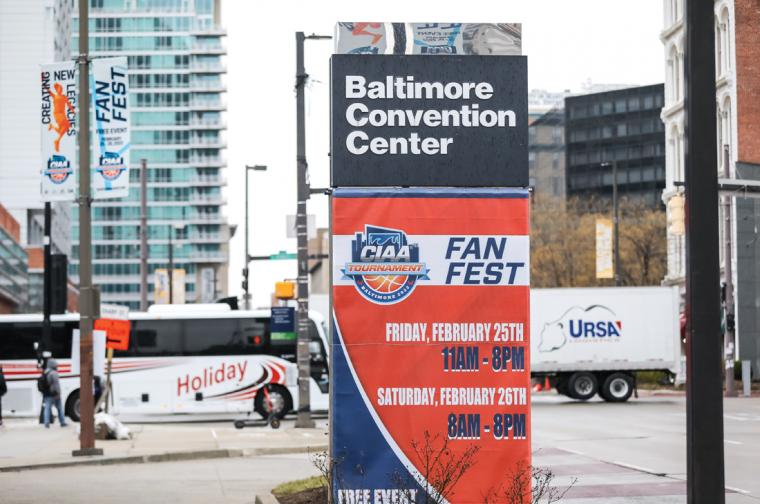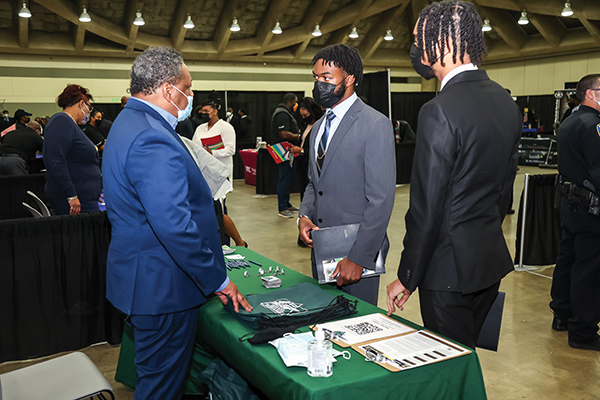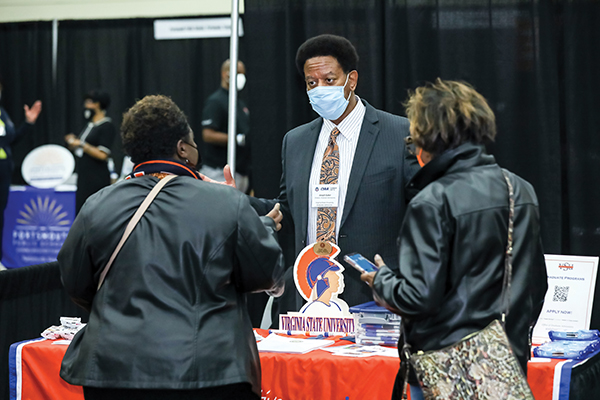
When – finally – the Central Intercollegiate Athletic Association (CIAA®), the nation’s oldest historically Black college athletic conference, was able to bring its Men’s and Women’s Basketball Tournament to Baltimore, Maryland in 2022 (one year late, thanks to nobody’s friend, COVID), the celebrations extended far beyond the Royal Farms Arena, where games took place.
And while alumni of the various HBCUs held multiple gatherings and receptions in nearby hotels and halls, another event at the Baltimore Convention Center was shaping the leaders of the future: an expo that was driven by the vision of providing opportunities for advancement.
The CIAA Career Expo was designed to provide organizations the opportunity to meet recent graduates, current students from the CIAA member schools and other universities, career seekers and career switchers and recruit for available positions. Employers, meanwhile, attended the expo to increase visibility, illustrate the benefits of employment within their organizations, and provide information regarding internships, full-time employment and post-graduate educational opportunities.
Also, during the course of the tournament, the CIAA held a virtual Education Day, where current high school students could learn about the various CIAA member institutions. (It is hoped this will return as a live event as well in years to come).
These events, as well as other activations around the tournament, have one thing in common: they started with a distinct vision of what organizers wanted to accomplish. And if you are planning to add a trade show or expo to your event, you too should be defining your vision. Here are some questions to ask yourself:
• What are your goals?
• Who would you like to have attending, both vendors and visitors?
• What should visitors be able to take away from your event?
• What do vendors want?
• And of course, how can you successfully deliver on both those needs, to create an event that really adds to your tournament?

It takes a tremendous amount of collaboration between stakeholders, including your client and the venue that is hosting the event, and it starts early. Trade shows and expos can necessitate months or even years of planning in order to be successful.
While we are proud to say that the CIAA, in conjunction with Visit Baltimore, produced a tournament that welcomed 36,390 total attendees (as tracked by Tourism Economics; Royal Farms Arena recorded 66,000 people through the turnstiles) and had a direct spending impact of $13.9 million, we are also impressed by the ability of the event to help connect growing businesses with bright young minds.
So, once you have defined your mission, what comes next, in terms of planning? You already know it’s essential to select your venue, preferably within walking distance of your event. But consider a few other things:
Advance Notice: The market has changed, and many vendor companies are still operating with smaller staffs and tighter budgets. The more notice you can give, the more likely you are to have a good vendor turnout. At a minimum, 12 months of advance planning should go into events; however, since the pandemic and the many disruptions it brought, timelines have been shaken up. Thankfully, we’re seeing things begin to return to normal. Still, planning should begin as soon as you lock in the dates and space for your event.
Creativity: What kind of incentives can you give that help entice visitors to enter your exhibit hall? At the recent Sports ETA Symposium, we saw our Marketplace use everything from an upscale morning coffee station sponsored by Mid-Atlantic Amateur Sports Alliance (MAASA) to a puppy-petting station hosted by a local shelter (really, who can resist rescued puppies?) to hosted bars, including those serving up Bloody Marys and Piña Coladas. In addition, many destinations offered regional snacks and treats to convince visitors to stop by their exhibits.
More and more, vendors are thinking beyond the 10’ x 10’ booth space, and outside the pipe and drape, and working to create more fun and interesting spaces. Coffee-table set-ups are becoming more common, as are barstool-and-bar configurations, all designed to encourage visitors to relax and spend some time at the booth talking. At Sports ETA, people want to connect above and beyond the speed-date format; for that reason, there are plenty of spaces (and opportunities) to sit down, relax and talk in an unprogrammed area.
Décor: What will help create the atmosphere that you want? Is it sport-specific, state-specific, school-specific or something else? Line it up in advance, speaking with vendors like souvenir companies, decorators, florists and others.
Sound: Are you having music piped in? Is there a public address system? How loud will the sound be? (You don’t want to make it so loud that people have to raise their voices to be heard over it; that can cause people to exit your trade show/expo in search of quieter spaces to talk). Plan out in advance with your audio vendor. Louder music can be used later, once the exhibit hall hours are officially over and happy hour has started.
A.V. is Important Too: If you’re using audiovisual, this is another aspect that should be planned in advance.
Placement is Essential: As vendors, everyone wants their exhibit to be “the place to be” during the day. But that shouldn’t mean that any one booth detracts overtly from others (whether by noise, by theme, by equipment or by anything else). Work to create an exhibit hall layout plan that encourages visitors to work their way through the whole hall. Spaces near the entry and near any bar are going to be considered more desirable but that may not be the best location for a booth where you anticipate everyone will congregate at the expense of other exhibitors.
Raffles/Scavenger Hunts: One idea to get every booth visited is to provide an exhibit “passport” card with the names of each vendor marked. If visitors stop at a booth to talk for a scheduled visit, they can have their card stamped. At the end of the conference, all fully stamped cards can be put into a drawing for a notable gift. (Alternatively, a smaller gift can be mailed to each person with a fully stamped card).

Sponsorship: Returning to the previous point about companies operating leaner and meaner these days, it’s unlikely that there will be extra funding to spare if you ask at the last minute. Creating activations around your expo (opportunities for hosting/sponsoring a happy hour, a cellphone charging station, an arrangement of coaches around TVs broadcasting the week’s biggest game, complete with snacks) – they all provide opportunities for more visibility for sponsors, provided you ask early.
All things considered, people are not going walk into the exhibit hall unless you give them a reason to do so, and unless you interest them enough to do so. We’ve seen everything from pinball machines to carnival games to celebrity appearances that draw people in. What you want them to walk out with, however, are those invaluable connections; at Sports ETA, it was new relationships for business. At the CIAA, it was the ability for individuals to connect with the companies that could offer them the opportunities they wanted. Are you planning to do an evaluation form visitors can fill out electronically, to make sure they’ve come away with a valuable experience? You should.
But the work doesn’t just end with the trade show itself. Make sure your event takes your vendors into consideration. Both move-in and move-out should be easy for your exhibitors. The exhibition company should have a booth set up in an inconspicuous area of the trade show and should be ready at all times to provide everything your vendors need onsite, including packing materials (tape, boxes, labels, etc.), shipping services and the ability to answer questions and process payments. (This is going to be essential to your exhibitors, who are sure to complain if they feel they have not been taken care of).
Your trade show or expo, if done correctly, should fit seamlessly with your event. It can incorporate fun sidelights (puppies!) or refreshments (local beers!) but most importantly, it should be the conduit between visitors and vendors. Both should come away with lasting relationships – and your organization should come away as a winner for setting them up. Just know what you want in advance and be willing to do the work to make that vision a reality. SDM

